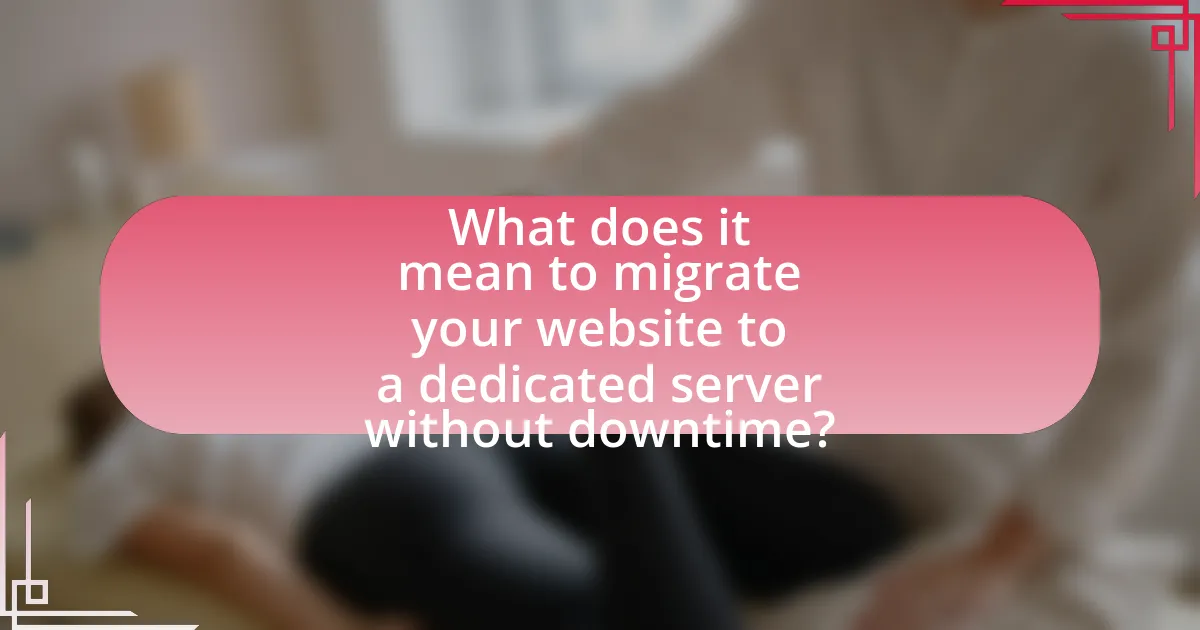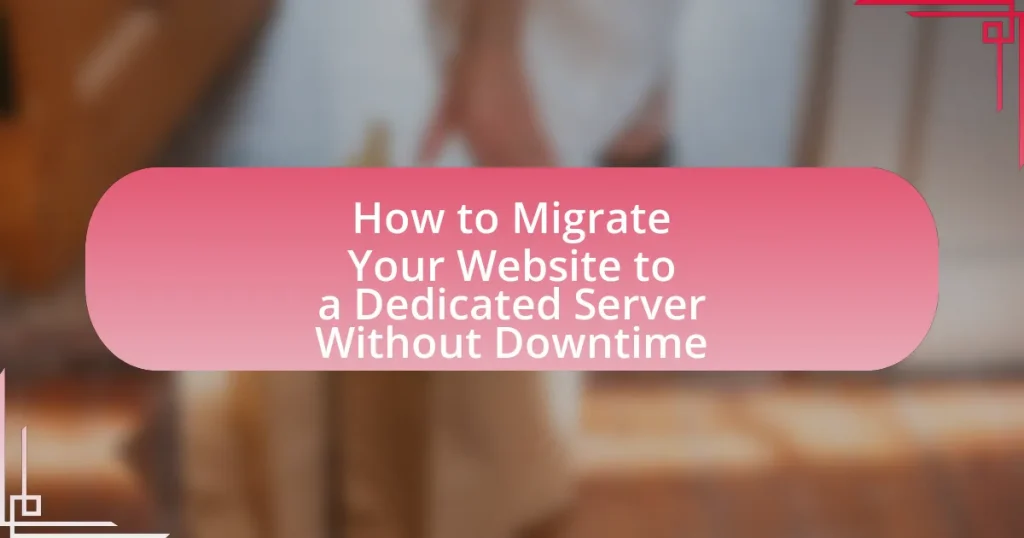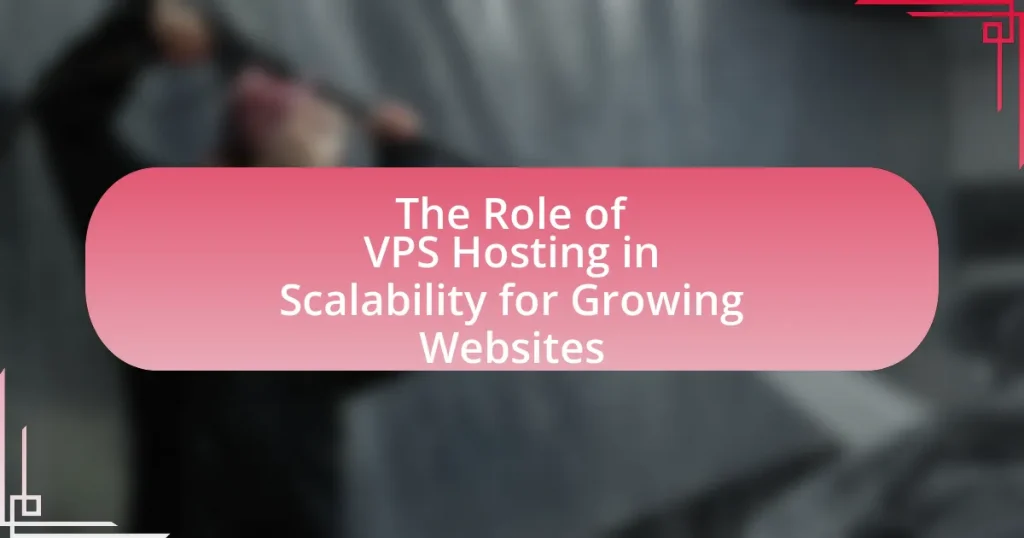Migrating a website to a dedicated server without downtime involves transferring data and functionality while maintaining user access throughout the process. Key steps include backing up data, setting up the new server, updating DNS settings, and testing the website’s functionality. Ensuring data integrity is crucial, with techniques like checksums recommended to prevent data loss. The article emphasizes the importance of avoiding downtime to protect user experience and SEO performance, while also detailing best practices for a seamless migration, including the use of staging environments and DNS management. Additionally, it outlines the benefits of dedicated servers, such as improved performance and security, and provides troubleshooting tips and resources for support during the migration process.

What does it mean to migrate your website to a dedicated server without downtime?
Migrating your website to a dedicated server without downtime means transferring your website’s data and functionality to a new server while ensuring that users can still access the site throughout the process. This is typically achieved through techniques such as DNS management, load balancing, and real-time data synchronization, which allow the old server to continue serving requests until the new server is fully operational. The effectiveness of this method is supported by industry practices that emphasize minimizing service interruptions, ensuring a seamless transition for users.
How does the migration process work?
The migration process involves transferring a website from one server to another, specifically to a dedicated server, while ensuring minimal or no downtime. This process typically includes several key steps: first, backing up all website files and databases to prevent data loss; second, setting up the new dedicated server environment to match the existing configuration; third, transferring the backed-up files and databases to the new server; fourth, updating DNS settings to point to the new server; and finally, testing the website on the new server to confirm functionality before fully switching over. Each of these steps is crucial to ensure a seamless transition and maintain website availability throughout the migration.
What are the key steps involved in the migration process?
The key steps involved in the migration process to a dedicated server without downtime include planning, preparation, execution, and testing. First, planning involves assessing the current website infrastructure and determining the requirements for the dedicated server. Next, preparation includes backing up all website data, configuring the new server, and ensuring compatibility with existing applications. Execution entails transferring files and databases to the new server while updating DNS settings to minimize downtime. Finally, testing involves verifying that the website functions correctly on the new server and monitoring performance to ensure stability. These steps are crucial for a seamless migration experience.
How can you ensure data integrity during migration?
To ensure data integrity during migration, implement a comprehensive validation process that includes checksums and data comparison techniques. This process involves generating checksums for the data before migration and then verifying these checksums against the data after migration to confirm that no corruption or loss has occurred. According to a study by the National Institute of Standards and Technology, using checksums can reduce data corruption rates significantly, ensuring that the integrity of the data is maintained throughout the migration process.
Why is it important to avoid downtime during migration?
Avoiding downtime during migration is crucial because it ensures continuous access to services for users, which directly impacts customer satisfaction and business operations. When a website experiences downtime, it can lead to lost revenue, decreased user trust, and potential damage to brand reputation. Studies indicate that even a single hour of downtime can cost businesses thousands of dollars, depending on their size and industry. For example, a report by Gartner estimates that the average cost of IT downtime is around $5,600 per minute. Therefore, minimizing or eliminating downtime during migration is essential for maintaining operational integrity and financial stability.
What impact does downtime have on user experience?
Downtime negatively impacts user experience by causing frustration and loss of access to services. When users encounter downtime, they may experience delays in loading times, inability to complete transactions, or loss of data, leading to decreased satisfaction and trust in the service. Research indicates that 47% of consumers expect a web page to load in two seconds or less, and 40% will abandon a website that takes more than three seconds to load. This highlights the critical importance of minimizing downtime to maintain a positive user experience.
How can downtime affect your website’s SEO?
Downtime negatively impacts your website’s SEO by causing search engines to be unable to access your site, which can lead to lower rankings. When a website experiences downtime, search engine crawlers cannot index its pages, resulting in a loss of visibility in search results. According to a study by Moz, websites that experience significant downtime can see a drop in organic traffic by up to 20% or more, depending on the duration and frequency of the outages. Additionally, prolonged downtime can lead to a decrease in user trust and engagement, further harming SEO performance.
What are the benefits of using a dedicated server?
Using a dedicated server provides enhanced performance, security, and control for hosting websites. Dedicated servers allocate all resources exclusively to one user, resulting in faster load times and improved reliability, which is crucial for high-traffic websites. Additionally, dedicated servers offer superior security features, including customizable firewalls and dedicated IP addresses, reducing vulnerability to attacks. Furthermore, users have complete control over server configurations, allowing for tailored software installations and optimizations that meet specific needs. This level of customization and resource allocation is supported by industry standards, which indicate that dedicated servers can handle significantly more traffic and provide better uptime compared to shared hosting solutions.
How does a dedicated server improve website performance?
A dedicated server improves website performance by providing exclusive resources that enhance speed, reliability, and security. Unlike shared hosting, where multiple websites compete for bandwidth and processing power, a dedicated server allocates all its resources to a single website, resulting in faster load times and better handling of high traffic volumes. Studies show that websites on dedicated servers can achieve up to 50% faster response times compared to those on shared hosting. Additionally, dedicated servers allow for optimized configurations tailored to specific application needs, further enhancing performance.
What security advantages does a dedicated server offer?
A dedicated server offers enhanced security advantages by providing exclusive resources and control over the server environment. This exclusivity minimizes the risk of security breaches that can occur in shared hosting environments, where multiple users share the same server resources. Additionally, dedicated servers allow for customized security configurations, including firewalls, intrusion detection systems, and specific software installations tailored to the unique needs of the business. The ability to implement strict access controls and monitor server activity in real-time further strengthens security measures. According to a study by the Ponemon Institute, dedicated servers can reduce the likelihood of data breaches by up to 50% compared to shared hosting solutions, highlighting their effectiveness in safeguarding sensitive information.

What preparations should you make before migrating?
Before migrating your website to a dedicated server, you should conduct a comprehensive backup of all website files and databases. This ensures that you have a complete copy of your site in case of any issues during the migration process. Additionally, you should assess your current hosting environment to identify any specific configurations or settings that need to be replicated on the new server. It is also crucial to test the new server setup in a staging environment to ensure compatibility and performance. Furthermore, informing your users about the migration schedule can help manage expectations and minimize disruptions. These preparations are essential to facilitate a smooth transition and prevent data loss or downtime during the migration.
How do you assess your current hosting environment?
To assess your current hosting environment, evaluate key performance indicators such as uptime, load times, and resource utilization. Monitoring tools like Google Analytics and server logs provide data on traffic patterns and server response times, which help identify bottlenecks. Additionally, reviewing your hosting provider’s service level agreements (SLAs) ensures that they meet your uptime and support expectations. For instance, a reliable hosting provider typically guarantees at least 99.9% uptime, which is crucial for maintaining website accessibility.
What metrics should you analyze before migration?
Before migration, you should analyze metrics such as website traffic, server performance, resource utilization, and error rates. Website traffic metrics, including unique visitors and page views, help determine the load the new server must handle. Server performance metrics, such as CPU and memory usage, indicate whether the current infrastructure can support the migration. Resource utilization metrics, including bandwidth and storage usage, provide insights into the necessary capacity of the dedicated server. Finally, error rates, such as 404 errors or server response times, highlight potential issues that need addressing before migration. Analyzing these metrics ensures a smooth transition to a dedicated server without downtime.
How can you determine the right dedicated server specifications?
To determine the right dedicated server specifications, assess your website’s resource requirements, including CPU, RAM, storage, and bandwidth. Analyze current traffic patterns and peak usage times to estimate the necessary processing power and memory. For instance, a website with high traffic may require a multi-core processor and at least 16GB of RAM, while a smaller site might function well with a dual-core processor and 8GB of RAM. Additionally, consider the type of applications running on the server; resource-intensive applications will necessitate higher specifications. Evaluating these factors ensures that the server can handle current and future demands effectively.
What tools and resources can assist in the migration process?
Tools and resources that can assist in the migration process include website migration plugins, backup solutions, and server management software. Website migration plugins, such as Duplicator and All-in-One WP Migration, streamline the transfer of files and databases, ensuring a seamless transition. Backup solutions like UpdraftPlus and BackupBuddy provide secure data storage, allowing for easy restoration if issues arise during migration. Additionally, server management software, such as cPanel or Plesk, offers user-friendly interfaces for managing server settings and configurations, facilitating a smoother migration experience. These tools are widely recognized for their effectiveness in minimizing downtime and ensuring data integrity during the migration process.
Which migration tools are recommended for seamless transitions?
Recommended migration tools for seamless transitions include Duplicator, All-in-One WP Migration, and UpdraftPlus. Duplicator allows users to create a package of their site, making it easy to move to a new server without downtime. All-in-One WP Migration simplifies the process by enabling users to export their entire site with a single click and import it on the new server. UpdraftPlus offers backup and restoration features, ensuring that data is secure during the migration process. These tools are widely used and have proven effective in facilitating smooth website migrations.
How can you utilize backup solutions effectively?
To utilize backup solutions effectively, implement a comprehensive backup strategy that includes regular, automated backups, and multiple storage locations. Regular backups ensure that data is consistently saved, minimizing the risk of data loss during migration. Automated systems can perform backups at scheduled intervals, reducing the likelihood of human error. Storing backups in multiple locations, such as on-site and cloud-based solutions, provides redundancy and enhances data security. According to a 2021 survey by the Data Backup and Recovery Association, 60% of businesses that experienced data loss did not have a reliable backup solution in place, highlighting the importance of effective backup strategies.

What strategies can you implement to ensure a smooth migration?
To ensure a smooth migration to a dedicated server without downtime, implement a comprehensive pre-migration plan that includes thorough testing, data backup, and a clear timeline. Conducting a detailed assessment of the current website infrastructure allows for identifying potential issues that may arise during migration. Additionally, performing a test migration on a staging server helps to uncover any compatibility problems or performance bottlenecks before the actual migration. Backing up all data ensures that no information is lost during the transition, and having a rollback plan in place provides a safety net in case of unforeseen complications. Finally, scheduling the migration during off-peak hours minimizes the impact on users, ensuring a seamless transition.
How can you create a migration plan?
To create a migration plan for moving a website to a dedicated server without downtime, first, assess the current website infrastructure and identify all components that need migration, including databases, files, and applications. Next, develop a detailed timeline that outlines each step of the migration process, ensuring to include backups of all data and configurations to prevent data loss. Additionally, establish a testing phase on the new server to verify functionality before the final switch. This approach minimizes risks and ensures a smooth transition, as evidenced by best practices in IT migration strategies that emphasize thorough planning and testing to avoid service interruptions.
What elements should be included in your migration checklist?
A migration checklist should include the following elements: pre-migration assessment, data backup, DNS configuration, server environment setup, application compatibility checks, testing procedures, and post-migration monitoring.
The pre-migration assessment involves evaluating the current website infrastructure and identifying potential issues. Data backup ensures that all website files and databases are securely saved before migration. DNS configuration is crucial for directing traffic to the new server without downtime. Server environment setup includes installing necessary software and configuring server settings to match the previous environment. Application compatibility checks confirm that all applications function correctly on the new server. Testing procedures involve running tests to ensure the website operates as expected after migration. Finally, post-migration monitoring helps identify and resolve any issues that arise after the migration is complete.
How do you schedule the migration to minimize impact?
To schedule the migration and minimize impact, conduct the migration during off-peak hours when website traffic is lowest. This approach reduces the number of users affected by potential downtime or performance issues. Additionally, implementing a phased migration strategy allows for testing and adjustments in real-time, ensuring that any issues can be addressed without significant disruption. Research indicates that scheduling migrations during late-night or early-morning hours can lead to a 30-50% reduction in user impact, as fewer visitors are online during these times.
What testing procedures should you follow post-migration?
Post-migration, you should follow comprehensive testing procedures that include functionality testing, performance testing, and security testing. Functionality testing ensures that all website features operate as intended, verifying links, forms, and interactive elements. Performance testing assesses the website’s speed and responsiveness under various loads, confirming that it meets expected benchmarks. Security testing involves checking for vulnerabilities and ensuring that data protection measures are in place, such as SSL certificates and secure access protocols. These procedures are critical to ensure a seamless user experience and maintain website integrity after migration.
How can you verify that the migration was successful?
To verify that the migration was successful, check the website’s functionality, performance metrics, and server response times. After migration, ensure that all pages load correctly, links function, and databases are intact. Utilize tools like Google PageSpeed Insights to assess performance and compare metrics before and after migration. Additionally, monitor server logs for errors and confirm that DNS settings have propagated correctly. These steps provide concrete evidence of a successful migration by ensuring that the website operates as intended on the new dedicated server.
What common issues should you look for after migration?
Common issues to look for after migration include broken links, missing files, and incorrect configurations. Broken links can occur if URLs change during the migration process, leading to 404 errors. Missing files may result from incomplete transfers, which can disrupt website functionality. Incorrect configurations, such as misconfigured DNS settings or server settings, can cause performance issues or downtime. Monitoring tools and website audits can help identify these problems promptly, ensuring a smooth transition to the dedicated server.
What are the best practices for migrating without downtime?
The best practices for migrating without downtime include using a load balancer, implementing a blue-green deployment strategy, and ensuring data synchronization between the old and new servers. A load balancer allows traffic to be distributed between the old and new servers, minimizing disruption. The blue-green deployment strategy involves maintaining two identical environments, where one is live while the other is updated, allowing for seamless switching. Data synchronization ensures that any changes made during the migration process are reflected on the new server, preventing data loss. These practices are validated by industry standards in IT migration, which emphasize the importance of minimizing service interruptions during transitions.
How can you implement a staging environment during migration?
To implement a staging environment during migration, create a duplicate of your live website on a separate server or subdomain. This staging environment allows for testing and validation of the migration process without affecting the live site. By using tools like rsync or migration plugins, you can synchronize files and databases to the staging environment, ensuring it mirrors the live site accurately. Testing in this environment helps identify issues such as broken links or functionality problems before the final migration, reducing the risk of downtime.
What role does DNS management play in avoiding downtime?
DNS management plays a critical role in avoiding downtime by ensuring that domain name resolutions are accurate and efficient during server migrations. Proper DNS management allows for the seamless transition of traffic from the old server to the new dedicated server, minimizing the risk of service interruptions. For instance, by lowering the Time to Live (TTL) settings before migration, website owners can ensure that changes propagate quickly, allowing users to access the new server without experiencing delays or errors. Additionally, implementing DNS failover strategies can provide redundancy, automatically redirecting traffic in case of server issues, further enhancing uptime.
What troubleshooting tips can help during the migration process?
During the migration process, verifying backups is crucial; ensure that all website data is securely backed up before initiating the migration. Additionally, testing the new server environment for compatibility with your website’s software and configurations can prevent issues. Monitoring DNS propagation is also essential, as it can take time for changes to take effect globally. If problems arise, checking error logs on both the old and new servers can provide insights into any issues encountered. Finally, having a rollback plan in place allows for quick recovery if the migration does not proceed as expected.
How do you handle unexpected issues during migration?
To handle unexpected issues during migration, implement a robust contingency plan that includes real-time monitoring and a rollback strategy. This approach allows for immediate identification and resolution of issues as they arise, minimizing downtime. For instance, utilizing tools that provide alerts for performance degradation can help in swiftly addressing problems. Additionally, having a backup of the website and database ensures that you can revert to the previous state if critical issues occur, thus maintaining service continuity.
What resources are available for support during migration?
Resources available for support during migration include dedicated server hosting providers, migration tools, and technical support services. Dedicated server hosting providers often offer migration assistance as part of their service, ensuring a smooth transition to the new server environment. Migration tools, such as website backup and transfer software, facilitate the process by automating data transfer and minimizing downtime. Additionally, technical support services, including live chat and phone support, are typically available from hosting companies to address any issues that arise during the migration process. These resources collectively help ensure a successful migration with minimal disruption.















